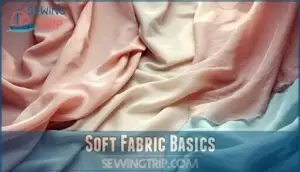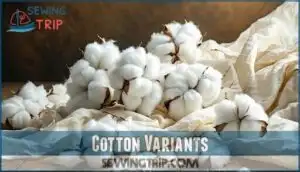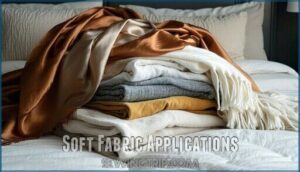This site is supported by our readers. We may earn a commission, at no cost to you, if you purchase through links.
 In the realm of the softest fabrics, you’ve got plenty of luxurious options.
In the realm of the softest fabrics, you’ve got plenty of luxurious options.
Natural materials shine here—silk feels smooth and cool against your skin, while cashmere delivers unmatched warmth without the itch.
Cotton is breathable, with variations like Egyptian cotton offering extra softness. Bamboo fabrics are a modern favorite, combining eco-friendliness and a silky touch.
For synthetics, modal and viscose mimic natural softness, making them great for cozy clothing. Each fabric type dances to its own tune of softness, suited to specific purposes like clothes or bedding.
Curious about care tips or how to pick the perfect one? Stay tuned!
Table Of Contents
Key Takeaways
- You’ll love natural fabrics like silk, cashmere, and bamboo for their unmatched softness and skin-friendly comfort.
- Synthetic options like modal and viscose feel just as soft, offering affordable and durable alternatives to natural materials.
- Proper care—like washing in cold water, using mild detergent, and air-drying—helps preserve your fabric’s softness over time.
- Softness depends on a combination of fiber quality, thread count, and fabric weave, so choose wisely for the ultimate cozy experience.
Soft Fabric Basics
Understanding soft fabric basics helps you recognize what makes a material comfortable and skin-friendly. Natural fibers, breathable weaves, and smooth textures all work together to create the softest fabrics.
Soft fabrics blend natural fibers, breathable weaves, and smooth textures to deliver unmatched comfort and skin-friendly coziness.
Natural Materials
Natural fabrics are nature’s gift to comfort.
Organic cotton offers softness and breathability, perfect for sensitive skin.
Wool types bring warmth and plush texture, ideal for chilly days.
Silk production creates lustrous, smooth materials that feel luxurious.
Bamboo properties boast softness, durability, and eco-friendliness.
Natural blends combine these qualities, making them among the softest natural fibers for everyday use and indulgence.
Breathable Fabrics
Breathable fabrics are perfect for Climate Comfort, keeping you cool and comfortable.
They blend Air Permeability, Moisture Wicking, and lightweight fibers into skin-friendly fabrics.
Look for these features:
- Loose Weave Structure for better airflow.
- Cotton, bamboo, and other softest natural fibers.
- Lightweight, moisture-absorbing textiles.
- Natural materials with airy construction.
- Comfortable clothing fabrics designed for ventilation.
The key to comfortable clothing is finding fabrics that balance Moisture Wicking properties with breathability.
Soft Textures
Soft textures bring immediate sensory appeal and elevate comfort levels.
When you touch the softest fabrics, their ultrasoft fabric feel and cloudlike fabrics offer unmatched tactile perception.
Plush fabric types like flannel or silky smooth textiles pamper your skin, perfect for those with skin sensitivity.
Fabric hand—how it feels—matters most, making these textiles ideal for ultimate coziness and everyday use.
For example, cashmere’s luxurious softness is highly sought after, offering an experience of ultimate coziness and cloudlike fabrics.
What Are Softest Fabrics
Now that you understand the fundamentals, let’s identify which fabrics truly deserve the title of "softest." When you’re shopping for comfort, certain materials stand out for their exceptional hand feel.
The world’s softest fabrics include:
Cashmere, silk, and bamboo lyocell deliver unmatched luxury, offering a gentle touch and cloudlike comfort for ultimate skin-friendly indulgence.
- Cashmere – Luxuriously soft with fine fibers that feel like a gentle hug
- Supima Cotton – Longer fibers create a silky smooth textile experience
- Micromodal – Incredibly plush fabric type derived from beech trees
- Silk – Nature’s most comfortable material with natural temperature regulation
- Bamboo Lyocell – Eco-friendly option with surprising softness
Softness perception factors include fiber denier effect (thinner fibers feel softer), weave impact softness (looser weaves often feel softer), and finishing treatments. While future fabric tech continues to evolve, these materials remain the gold standard when you’re seeking that "sleeping on a cloud" feeling for your skin.
Fabric Types Explained
You’ll find a variety of fabric types that offer different levels of softness, from natural cotton variants to synthetic blends with unique properties.
Understanding these differences helps you choose the right material for your clothing, bedding, or accessories based on your comfort preferences and practical needs.
Cotton Variants
Cotton variants offer distinctly different qualities at various price points.
You’ll find that Pima cotton benefits include exceptional softness and resilience, while Egyptian cotton drape creates an elegant look in bedding and clothing.
Thread count importance impacts smoothness, but quality is paramount.
| Cotton Type | Key Features | Cost Factor |
|---|---|---|
| Upland Cotton | Standard softness, 90% of production | Lowest cost |
| Pima Cotton | Extra soft, tear-resistant | Mid-range |
| Egyptian Cotton | Silky smooth texture, luxurious drape | Premium |
The Pima cotton and Egyptian cotton are notable for their unique characteristics, with extra soft and tear-resistant properties making them stand out.
Synthetic Materials
Surprisingly, synthetic materials often rival natural fibers in the softness department.
Polyester benefits include durability and wrinkle resistance, while rayon alternatives offer silk-like texture at affordable prices.
Viscose properties include excellent draping and breathability. Modal advantages feature exceptional softness that improves with washing.
Satin uses extend from luxurious bedding to elegant clothing. Among softest fabrics, fleece and sherpa provide plush comfort without the premium price of natural materials.
Fabric Blends
The perfect combination of comfort and performance, fabric blends merge the best qualities of different materials.
You’ll find poly/cotton blends offer superior durability while maintaining breathability at a reasonable cost.
Cotton/rayon mixtures provide exceptional softness against your skin.
Many sustainable blends incorporate bamboo fibers, creating some of the softest fabrics available.
These gentle-on-skin combinations serve various applications from casual wear to luxury bedding.
Measuring Fabric Softness
You’ll find that fabric softness can be measured through both touch assessment and scientific methods like bending and compression tests.
These measurements help determine which textiles provide the ultimate comfort for your clothing and home textiles, and help assess fabric softness.
The Feel Test
Run your fingers across a fabric to conduct the feel test—your most intuitive softness assessment tool. This subjective evaluation relies on your sensory perception and touch sensitivity.
Here’s how to properly assess fabric hand:
- Use fingertips for maximum sensitivity
- Compare against known standards
- Test both sides of the fabric
- Evaluate in different lighting conditions
- Consider temperature effects on perceived comfort
The feel test provides immediate feedback on fabric texture that resonates with your personal comfort preferences.
Scientific Softness
When measuring fabric softness scientifically, researchers examine several key factors.
Fiber structure and molecular properties determine the base level of softness, while yarn density affects how the fabric feels against your skin.
Professional softness testing uses instruments that measure compression and bending resistance.
Fabric treatments can enhance these properties through chemical processes, helping manufacturers create consistently soft fabrics that meet specific comfort standards.
Soft Fabric Applications
You’ll find soft fabrics in everything from your daily clothing to luxurious bedding and practical accessories.
These materials enhance comfort in garments like t-shirts and underwear, create inviting sleep environments with sheets and pillowcases, and add a gentle touch to scarves, bags, and other items you use regularly, which all contribute to a sense of luxurious feel.
Clothing Uses
In your daily wardrobe, soft fabrics play an essential role in both comfort and style.
From lightweight cotton for everyday apparel to luxurious silk for formal wear, your clothing choices affect how you feel throughout the day.
- T-shirts and loungewear made from bamboo or modal offer unmatched comfort for sensitive skin
- Activewear comfort comes from moisture-wicking, soft synthetic blends
- Baby clothing requires the gentlest skinfriendly fabrics like organic cotton or fleece
Bedding Uses
Beyond clothing, soft fabrics create your most intimate sanctuary: your bed. You’ll spend a third of your life between sheets, so fabric choice matters substantially.
The right weave type impacts comfort too. For seasonal bedding, consider lightweight percale for summer and flannel for winter.
| Fabric Type | Thread Count | Comfort Level |
|---|---|---|
| Egyptian Cotton | 400-1000 | Cloud-like softness |
| Bamboo Lyocell | 300-500 | Silky and breathable |
| Microfiber | 200-800 | Cozy and warm |
Superior bedding options enhance sleep quality. Hypoallergenic options like bamboo bedding sets protect sensitive sleepers while maintaining that dreamy comfort.
Accessories
Three accessory categories benefit most from soft fabrics: scarves, gloves, and handbags.
When accessory design meets comfort priorities, you’ll notice the difference against your skin.
Consider fabric sourcing carefully—silk scarves for summer, cashmere gloves for winter.
Seasonal softness matters, especially for items touching sensitive areas.
Blended accessories often combine gentle fabric options with structural elements, giving you both luxury and practicality in smooth fabric surfaces.
Caring for Soft Fabrics
You’ll need to properly care for your soft fabrics to maintain their luxurious feel and extend their lifespan.
The right washing techniques, drying methods, and storage practices can preserve the natural softness of your favorite materials while preventing damage and premature wear, which helps to maintain their natural softness.
Washing Techniques
With tender care, washing your soft fabrics properly preserves their luxurious feel. Choose the right water temperature and detergent for each fabric type to maintain softness.
- Cold water preserves fibers and prevents shrinkage in most delicate materials
- Mild, pH-balanced detergents protect fabric integrity without harsh chemicals
- Gentle cycle selection reduces friction that can damage soft fibers
- Hand washing provides the gentlest cleaning method for extremely delicate pieces
Using a quality laundry solution can extend fabric life and help maintain their softness with the right detergent and gentle cycle.
Drying Methods
Always check fabric drying instructions to pick the right method.
Air drying preserves softness and protects delicate fabrics. Tumble drying works but use low drying temperature and always separate fabric types.
Add dryer sheets to boost softness retention techniques. Consider using quality dryer sheets for superior results.
Avoid overheating, as it can damage fibers. These fabric drying tips guarantee softness washing results stay perfect post-laundry, ensuring delicate fabrics are protected and promoting superior results.
Storage Tips
Now that your soft fabrics are properly dried, proper storage will preserve their luxurious feel.
Fold your garments neatly rather than hanging to prevent stretching. Control humidity in your storage area to avoid mildew.
Use cedar blocks or lavender sachets for moth prevention while adding aromatic storage benefits. Maximize space optimization with fabric-friendly containers.
Remember, how you store soft fabrics directly impacts softness retention—treat them like the treasures they are.
Soft Fabric Properties
You’ll find that soft fabric properties depend on yarn thickness, thread count, and finishing techniques that determine how a textile feels against your skin.
The finest fabrics combine thin, minimally twisted yarns with high thread counts and special treatments like brushing or enzyme washing to create that luxurious sensation you love.
Yarn Properties
Now that you know how to care for your soft fabrics, let’s look at what makes them soft in the first place.
Yarn properties substantially influence fabric softness. The less twist in yarn, the softer your fabric feels.
Longer fiber length creates smoother textures, while single-ply yarns typically feel gentler than multi-ply varieties.
Lighter yarn weight produces more delicate fabrics. You’ll find that finer yarn texture directly correlates with increased fabric softness, and single-ply yarns are often preferred for their gentle feel.
Thread Count
While yarn thickness affects how fabric feels against your skin, thread count plays an equally important role in softness perception.
Higher thread counts typically mean smoother, softer fabric surfaces because more threads are packed into each square inch.
However, beware of thread count myths—numbers above 800 rarely improve comfort.
The ideal thread count varies by material: 200-400 for cotton and 300-600 for most comfortable materials like Egyptian cotton.
Weave impact matters just as much, and understanding this can greatly affect the overall feel and quality of the fabric, making higher thread counts less critical than once thought.
Fabric Finishes
Beyond thread count, fabric finishes transform ordinary textiles into super-soft materials.
You’ll find various treatments like brushing techniques that create fuzzy surfaces similar to flannel, enzyme washing that smooths rough fibers, and chemical softeners that enhance touch.
Mechanical finishing breaks down stiffness, while emerging technologies develop fabric finishes specifically for sensitive skin.
These processes can turn even basic fabrics into luxurious ones you’ll love against your skin.
Softest Natural Fabrics
You’ll find exceptional comfort in natural fabrics like silk, wool, and bamboo, each offering unique softness properties that synthetic materials can’t match.
These materials provide superior breathability and temperature regulation while getting softer with each wash, making them ideal choices for both luxury items and everyday comfort.
Silk
Silk, the queen of fabrics, offers unparalleled luxury for those with sensitive skin.
You’ll appreciate its natural protein fibers that create a gentle, smooth surface against your skin. Silk production involves harvesting cocoons from silkworms, with higher grades providing exceptional softness.
It’s hypoallergenic, breathable, and temperature-regulating—keeping you cool in summer and warm in winter.
Proper silk care maintains its luxurious properties for years.
Wool
Wool, a natural treasure, stands out for softness and comfort.
From Merino Wool’s gentle fibers to premium Wool Grades like Cashmere, softness factors depend on fine microns, ideal for sensitive skin.
Wool Blends balance durability and softness, while thoughtful Wool Care—gentle washing and air drying—preserves this fabric’s luxurious feel.
One popular option is to use brushed flannel blankets for extra insulation. Opt for wool alternatives for softness in every season.
Bamboo
Bamboo fabric is an incredibly soft, breathable material that’s gentle on skin, making it a top choice for sensitive skin.
Known for its sustainability, bamboo production reduces environmental impact compared to other fabrics.
Bamboo’s applications range from clothing to bedding, offering comfort and versatility, and is often found in bamboo blends, making it one of the best fabrics for comfort and eco-friendliness.
Maintaining Softness
Keeping your fabrics soft isn’t as tricky as it might seem, but it does take a little care.
By preventing shrinkage, removing stains promptly, and using the right softening techniques, you can preserve their luxurious feel for years.
Preventing Shrinkage
To keep soft fabrics for sensitive skin intact, focus on fabric care.
Wash with cool water to protect fabric fibers and prevent shrinkage.
Use drying methods like air-drying or low-heat settings.
Select materials with balanced blend ratios, as they’re less prone to fabric shrinkage.
Pre-shrinking fabrics before sewing also guarantees consistent softness and fit.
Removing Stains
Stains can ruin the softness of your favorite fabrics if ignored. Acting quickly is key.
Gently blot spills before they set. Use natural stain removers like baking soda or vinegar for gentle fabric care. Avoid hot water, which can worsen fabric staining.
Check care labels for fabric-specific stains to protect softness. Enzyme-free detergents are ideal for delicate materials.
Prevention? Treat spills immediately.
- Blot spills promptly.
- Use cold water on fresh stains.
- Test stain removers before full application.
- Avoid rubbing, which can damage fibers.
- Check care labels for proper stain removal.
Fabric Softening Techniques
Maintaining fabric softness can be simple with a few tricks.
A vinegar rinse breaks residue, while baking soda balances pH for smooth fibers.
Dryer balls enhance softness by separating fibers as they dry.
Fabric softeners coat materials for a plush touch.
Steam ironing gently relaxes fibers, adding to softness factors.
These fabric care for softness methods guarantee lasting comfort.
Frequently Asked Questions (FAQs)
What is the most comfy fabric?
For ultimate comfort, go for fabrics like cotton, bamboo, or modal.
They’re soft, breathable, and perfect year-round.
These materials keep you cozy, regulate temperature, and feel gentle on your skin day after day.
What fabric is softer than cotton?
It’s funny how softness can surprise you—modal fabric, made from beech tree pulp, is softer than cotton.
It’s unbelievably smooth, breathable, and keeps its color well, making it perfect for luxury feeling clothes.
What is the softest most expensive fabric?
The softest, most expensive fabric is vicuña wool.
It’s sourced from the rare vicuña, a cousin of the llama, found in the Andes.
Only a few ounces are harvested per animal, making it highly luxurious.
What is the soft smooth fabric called?
Imagine silk gliding through your fingers—it’s the epitome of soft, smooth luxury.
Satin, with its lustrous finish, also fits the bill.
These fabrics are perfect for creating elegant, indulgent, and touchably soft garments.
What is the most cost-effective way to make fabric soft?
To make fabric soft affordably, use vinegar in the rinse cycle to break down fibers, baking soda to balance pH, and dryer balls to fluff fibers.
These simple steps help achieve lasting softness.
What is the best fabric for people with sensitive skin?
You might worry about reactions, but natural fabrics like organic cotton or bamboo are hypoallergenic, soft, and breathable.
They minimize irritation, making them perfect if you’ve got sensitive skin or allergies.
Stick with easy-care options, as they are ideal for individuals with sensitive skin, and natural fabrics can provide numerous benefits.
What are the best washing practices for soft fabrics?
Wash soft fabrics in cold water with mild detergent, inside out, on a gentle cycle.
Avoid overloading, bleach, or high heat.
Air-dry flat or use low heat.
Follow care labels to preserve softness.
How can I make my clothing softer?
To soften clothing, use vinegar during the rinse cycle or add dryer balls.
Wash with mild detergent, avoid high heat, and air-dry when possible.
Enzyme washing or fabric softener also adds that silky touch.
What are the benefits of using soft fabrics?
Soft fabrics enhance comfort, cradle your skin gently, and minimize irritation.
They’re perfect for sensitive skin, wick moisture effectively, and retain warmth.
Plus, they add elegance and luxury, transforming everyday wear into a cozy retreat.
How does fabric weave impact softness perception?
Surprisingly, the softness you feel often depends on the fabric weave.
Loose weaves, like knits, create a cozy texture, while tight weaves, like satin, offer sleek smoothness.
Weave type controls softness, creating distinct tactile experiences.
Conclusion
Did you know silk has been prized for over 4,000 years for its unparalleled smoothness?
Understanding what’re the softest fabrics guarantees you can match their unique qualities to your needs.
Whether it’s the breathable comfort of cotton, the eco-friendly allure of bamboo, or the luxurious warmth of cashmere, these fabrics enhance life’s essentials—from clothing to bedding.
By choosing and caring for them well, you can enjoy their softness for years, guaranteeing style and comfort go hand in hand.



















